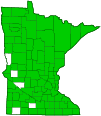Pennsylvania sedge
(Carex pensylvanica)
Conservation • Description • Habitat • Ecology • Use • Distribution • Taxonomy
Conservation Status |
|
|||||||
| IUCN Red List | not listed |
|||||||
| NatureServe | N5 - Secure SNR - Unranked |
|||||||
| Minnesota | not listed |
|||||||
Description |
||
Pennsylvania sedge is a short, tuft-forming sedge. It rises on a single shoot or a loose or dense clump of tufts from a horizontal, long-creeping stem (stolon). The stolon is slender, scaly, reddish, and up to 10″ long. It is aboveground but often buried under leaf litter and other debris. Both fertile and sterile stems (culms) are produced. The culms are triangular in cross section, reddish-purple at the base, hairless, and 4″ to 16″ tall. They are sheathed at the base with remnants of old leaves. Sterile culms are usually shorter than the leaves, fertile culms usually longer. Flowering spikes at the top of fertile culms are never hidden among the leaf bases. There are two to several leaf blades per culm. Leaf blades are green, ascending to arched outward, 2″ to 16″ long, and 1 ⁄32″ to ⅛″ wide. They are V-shaped in cross section, at least when young. The upper and lower surfaces are hairless and rough to the touch. The margins are mostly flat. The lower part of the leaf that surrounds the stem (sheath) becomes fibrous with age. The membrane where the leaf meets the stem (ligule) is short and broadly V-shaped. The inflorescence at the end of each fertile culm is a male (staminate) spike terminating the stem above 1 to 3 lateral female (pistillate) spikes. Each spike is closely subtended by a single short modified leaf (bract). The staminate spike is short stalked or stalkless and 3 ⁄16″to 1″ long. It is densely covered with overlapping scales. The scales are ⅛″ to 3 ⁄16″long and egg-shaped to elliptic. They are green but usually strongly tinged with reddish-brown. The margins are white. Three stamens with yellow anthers emerge from the top of each scale. The pistillate spikes are stalkless and ⅛″ to ⅜″ long. They are usually very close to but not overlapping the staminate spike. Each pistillate spike is densely covered with 4 to 13 scales. The pistillate scales are 1 ⁄16″ to ⅛″ long, egg-shaped, and dark reddish-brown. They have a green midrib and narrow white margins. They are often blackened with fungus. Each scale covers a scale-like bract (perigynium) that encloses the female flower. The perigynium is about ⅛″ long, narrowly egg-shaped, and olive green to yellowish-green, often with a purplish tip. Three white stigmas emerge from a small opening at the tip of each perigynium. The fruit is a dry, reddish-brown, one-seeded capsule (achene). It matures in April or May and drops from the plant soon after. |
||
Height |
||
4″ to 16″ |
||
Similar Species |
||
Habitat |
||
Dry to moderate moisture. Wide range of prairies and woods. Sandy soil. Partial sunlight. |
||
Ecology |
||
Flowering |
||
Pennsylvania sedge and other Acrocystis sedges are the first sedges to flower each year. |
||
Maturing |
||
Early May to late June |
||
Use |
||
|
||
Distribution |
||||
|
Sources |
|||
| 2/6/2022 | ||||
Nativity |
||||
Native |
||||
Occurrence |
||||
Common and widespread |
||||
Taxonomy |
|||
| Kingdom | Plantae (Plants) | ||
| Subkingdom | Pteridobiotina | ||
| Phylum | Tracheophyta (Vascular Plants) | ||
| Class | Liliopsida (Monocots) | ||
Order |
Poales (grasses, sedges, cattails, and allies) | ||
Family |
Cyperaceae (sedge) | ||
| Subfamily | Cyperoideae | ||
| Tribe | Cariceae | ||
Genus |
Carex (true sedges) | ||
| Subgenus | Carex | ||
| Section | Acrocystis | ||
Synonyms |
|||
Carex marginata Carex stolonifera Carex pensylvanica var. glumabunda Carex pensylvanica var. marginata |
|||
Common Names |
|||
early sedge Penn sedge Pennsylvania sedge yellow sedge |
|||
Glossary
Achene
A dry, one-chambered, single-seeded seed capsule, formed from a single carpel, with the seed attached to the membranous outer layer (wall) only by the seed stalk; the wall, formed entirely from the wall of the superior ovary, does not split open at maturity, but relies on decay or predation to release the contents.
Bract
Modified leaf at the base of a flower stalk, flower cluster, or inflorescence.
Culm
The hollow or pithy stem of a grass, sedge, or rush.
Ligule
In grasses, a membranous appendage at the junction of the leaf and the leaf sheath, sometimes no more than a fringe of hairs. In flowering plants, the flat, strap-shaped, petal-like portion of the corolla of a ray floret.
Perigynium
In Carex and other closely related sedges, a sac-like or flask-shaped, highly modified bract that surrounds the pistillate flower and later encloses the achene. Plural: perigynia.
Sheath
The lower part of the leaf that surrounds the stem.
Stigma
In plants, the portion of the female part of the flower that is receptive to pollen. In Odonata and Hymenoptera, a blood-filled blister or dark spot at the leading edge of each wing toward the tip, thought to dampen wing vibrations and signal mates. In Lepidoptera, an area of specialized scent scales on the forewing of some skippers, hairstreaks, and moths.
Stolon
An above-ground, creeping stem that grows along the ground and produces roots and sometimes new plants at its nodes. A runner.
Visitor Photos |
|||||
Share your photo of this plant. |
|||||
| This button not working for you? Simply email us at info@MinnesotaSeasons.com. Attach one or more photos and, if you like, a caption. |
|||||
Nancy Falkum |
|||||
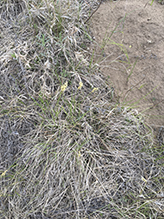 |
|||||
Luciearl |
|||||
| Small clumps of these sedges are blooming everywhere now. Most of the year they are mistaken for grass, but are a much prettier brighter green. |  |
||||
MinnesotaSeasons.com Photos |
|||||
Plant |
|||||
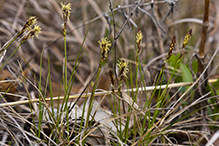 |
 |
||||
 |
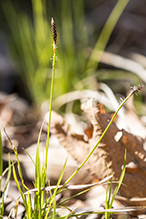 |
||||
 |
|||||
Inflorescence |
|||||
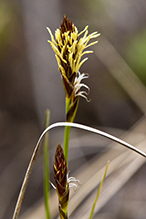 |
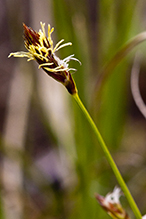 |
||||
 |
|||||

Slideshows |
||

Visitor Videos |
|||
Share your video of this plant. |
|||
| This button not working for you? Simply email us at info@MinnesotaSeasons.com. Attach a video, a YouTube link, or a cloud storage link. |
|||
Other Videos |
|||
| Carex pensylvanica - Pennsylvania Sedge PrairieMoonNursery |
|||
About
Uploaded on Apr 13, 2011 http://www.prairiemoon.com Carex pensylvanica, Pennsylvania Sedge, also called Common Oak Sedge can be difficult to grow from seed so we suggest buying plants. |
|||
| Carex pensylvanica Blowing in the Wind hiramgrad01 |
|||
About
Uploaded on Apr 16, 2011 Pensylvania sedge closeup showing stigmas of female flowers "looking" for Pollen |
|||


|
Created: Last Updated: © MinnesotaSeasons.com. All rights reserved. |
